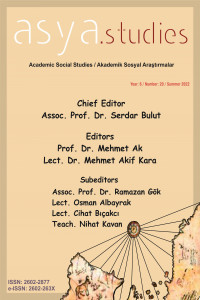EUGENE O’NEİLL’İN THE HAIRY APE (KILLI MAYMUN) OYUNUNDA İŞÇİ YANK’IN (AMERİKAN) RÜYASI’NDAN UYANIŞI: SIRADAN BİREYİN TRAJEDİSİ VE SINIFLARARASI GEÇİŞMEZLİK
Kıllı Maymun Amerikalı oyun yazarı Eugene O’Neill tarafından yazılan, dört tanesi gemide, dört tanesi ise geminin dışında olmak üzere toplam sekiz adet sahneden oluşan ve gemide ateşçi olarak çalışan bir işçinin düşünsel çatışmalarını, ruhsal bunalımlarını ve anlamsızlığa sürükleniş öyküsünün sonunda uğradığı yıkımı anlatan bir oyundur. Oyunun ana kişisi Yank Smith, büyük uluslararası bir yolcu gemisinde geminin hareket etmesini sağlayan kömürün ocaklara atılması ve böylece buhara dönüşerek yol almasını sağlayan ateşçilerden birisidir. Orta yaşlı, iri yapılı, güçlü, esmer birisi olarak betimlenmiştir. İşçilere özgü bir kabalığı olan Yank eğitimsiz, derin düşünme yeteneğinden yoksun, toplumun yapısından habersiz birisidir. Kendine aşırı bir güveni olan Yank, varlığını ve kimliğini gemideki işi ile özdeşleştirir. Yaptığı işin dünyanın dönmesi açısından çok önemli olduğunu düşünür ve bu yüzden bir bakıma Amerikan Rüyası’nın temsiline dönüşür. Ancak geminin alt bölümünde çalışan ve yaşayan işçileri görmeye gelen, Burjuvazi sınıfının tipik bir temsilcisi olan Mildred Douglas adlı genç bir kadının, Yank’i görmesi, onu “kıllı maymun”a benzetmesi ve bayılması üzerine, Yank kimlik bunalımına girer. İşçi sınıfının tipik bir temsilcisi konumundaki Yank, kimlik bunalımını aşmak ve hayatın kendisi açısından anlamını bulabilmek adına giriştiği çabada sınıflararası geçişmezlik ilkesi doğrultusunda başarılı olamaz. Sıradan insanın trajedisini gözler önüne seren oyun, ana kişi Yank’in kendisine karşı kayıtsız, katı sınıfçı Amerikan toplumunun içinde aidiyet ve kimlik arayışının bir anlatısıdır. Bu makalede, oyunun dışavurumcu özelliklerinden bahsedilerek, yabancılaşma, aidiyetsizlik, yalnızlık ve kimlik arayışı izlekleri sınıf çatışması bağlamında simgesel ve sembolik değerlerle bağlantılı olarak çözümlenecektir.
THE LABOURER YANK’S AWAKENİNG FROM THE (AMERİCAN) DREAM İN EUGENE O’NEILL’S THE HAIRY APE: THE TRAGEDY OF ORDINARY INDIVIDUAL AND CLASS IMMUTABLITY
The Hairy Ape is a play written by the American playwright, Eugene O’Neill. It consists of a total of eight scenes, four on board the ship and four off the board, narrating the ideologic dilemmas, psychological distress and the story of slowly falling into meaningless of the main character, a labourer working as a fireman in a transatlantic liner. The protagonist of the play, Yank Smith is one of the stokers, who throw coal into the furnaces of the transatlantic liner, which enables the ship to move by turning the coal into steam. He is portrayed as a middle-aged, well-built, strong and dark-skinned person. Yank has the usual and expected roughness/crudeness of a labourer. He is an uneducated person, deprived of deep thinking potential, and unaware of the social structure of the community he lives in. He has too much self-confidence and associates his whole existence and identity with his work on the liner. He regards his work as of supreme importance as he believes this makes the world rotate. This self-perception turns him into the symbol of American Dream. However, his self-confidence and perception is shattered upon hearing the word “filthy beast”, uttered by Mildred Douglas, a typical representative of the Bourgoise, having come down to witness the working conditions of the “other half”. Yank, a typical representative of the working class, cannot succeed in his effort to overcome the identity crisis. He fails in his attempt to find meaning in life itself, and this is in line with the principle of class immutability. The play, which reveals the tragedy of the common man, is a narrative of the protagonist Yank's search for belonging and identity in the strictly class-based American society, which is indifferent to him. In this article, the expressionist features of the play will be stressed, and the themes of alienation, loss of belonging, loneliness, identity search will be analysed in line with the signs and symbols presented within the context of class clash.
___
- Abrams, M. H. (1978). A Glossary of Literary Terms, (Third Edition). Madras: Macmillan.
- Aşkaroğlu, V. (2018). İlkel İnsan ve Diktatörlüğün Kurulması: Hayvan Çiftliği İle Karanlığın Yüreği Romanlarının Karşılaştırması. Karadeniz Uluslararası Sosyal Bilimler Dergisi, 37(37), 169-178.
- Aşkaroğlu, V. (2017). Toplum ve Birey: Yabancılaşma Üzerine Kuramsal Bir Tartışma. Karadeniz Uluslararası Sosyal Bilimler Dergisi, 35(35), 72-77.
- Cardullo, R. J. (2012). Eugene O’Neill’s The Hairy Ape in Relation to Greek Tragedy, Italian Futurism, and Divine Comedy. Moderna Sprak, 106(2), 25-41.
- Brugnoli, A. (2012). Eulogy of the Ape: Paradigms of Alterity and Identity in Eugene O'Neill's The Hairy Ape. Eugene O’Neill Review, 33(1), 43-55.
- Hochman, S. (ed.) (1984). Mcgraw-Hill Encyclopedia of World Drama. (4th Vol). New York: McGraw-Hill.
- O’Neill, E. (1967). The Hairy Ape. (Ed. Egbert. S. Oliver). American Literature 1890-1965: An Anthology In (p.173-211). New Delhi: Eurasia Publishing House.
- Öğünç, B. (2018). Where Do I Belong? Power and Class Struggle in Miss Julie and The Hairy Ape. Gaziantep Üniversitesi Sosyal Bilimler Dergisi, 17(3), 857-865.
- Rachana, M. (2014). Identity Crisis in Eugene O’Neill’s The Hairy Ape”. New Man International Journal of Multidisciplinary Studies, 1(10), 25-33.
- Raleigh, J. (1967). Eugene O'Neill. The English Journal, 56(3), 367-475.
- Roy, E. (1968). Eugene O’Neill’s The Emperor Jones and The Hairy Ape as Mirror Plays. Comparative Drama, 2(1), 21-31.
